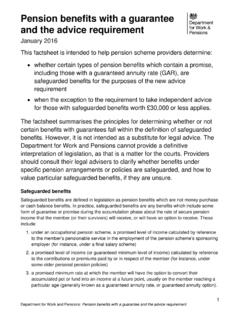Transcription of What is the TFR? - OECD
1 what is the TFR? "Trattamento di Fine Rapporto" a sort of severance pay, or deferred salary, applied to all employed workers in the private sector of current salary kept by the employer as book reserves paid to the employee at termination of employment may be withdrawn earlier in some cases ( : after 8 years of employment, to finance expenses for serious illness, or the purchase of the family home) Average length at payment is 7 years revaluation rate preserves its real value against inflation: 1,5% + 3/4 of inflation rate what is the TFR? In summary: for the employee: a sort of mandatory saving that offers protection against unemployment or important family and personal needs For the employer: a cheap source of financing In general, it is not considered as a DB pension scheme (possibly except for single-employer long-life carriers) Trade unions favour the payment of (flows of) TFR into pension funds Employers would have liked to keep the TFR as it is (the employers compensation and credit facilities for small enterprises The 2005 reform Previous (current) situation: Structural reform of public 1st pillar in 1992-1995.)
2 Introduced NDC system, with a long transition period Sharply reduced replacement rates (from 70-70% of final salary to 50%) Aimed at defelopment of private pensions but: coverage rate insufficient, currently still at 13% The 2005 reform (originally set to enter into force in 2008) (flow of ) TFR automatically paid into pension funds, into a very conservative default investment line The pension fund that will receive the TFR typically is the industry-wide occupational pension fund Trade unions and the employer may decide to opt-out from the industry-wide fund and divert the TFR and agreed additional contributions to open pension funds on a group basis Single employees may explicitly refuse to accept the transfer of TFR to pension funds and keep it with the employer Single employees may also explicitly choose to divert their TFR individually to a personal pension plan.
3 But in this case they do not have the right to carry there also the employer s contribution Subsidized credit facilities to firms and some fiscal compensation Revisiting the 2005 reform No final formal decisions taken, Entry into force anticipated to 2007 Default mechanism unchanged, In the case the single employee refuses the transfer of the TFR to the pension funds: o For firms < 50 workers, TFR will stay in the firm o For firms with > 50 workers, TFR will go to the INPS (National Social Security Institute), with no change in workers rights Gvt estimates: 6bil euro will go to INPS, decreasing the budget deficit according to Eurostat methodology.
4 About the same amount to PFs and to (small) firms Final comments using the severance pay to finance PFs is a natural choice, but there may be serious drawbacks in terms of impact: o on firms financial position and competitiveness (perceived tax wedge on labour does not decrease) o on workers, if severance pay acts as an insurance against unemployment, etc. (unless liquidability of severance pay is allowed also for PFs) Italy s mechanism of automatic transfer of TFR to PFs plus the hierarchy of collective and individual decisions may represent an interesting hybrid bw. systems based on pure DC individual accounts w. only individual responsibility and fully paternalistic systems based on large DB PFs Remaining major areas of concern Coverage rate across firms of different size Conservative default option.
5 Will it be a buffer choice? Rationale of the transfer of TFR to INPS Actual diffusion of a culture that fully accepts a significant role of private sector and of collective and individual choices in the provision of pensions for the emploa sort of severance pay, or deferred salary, applied to all employed workers in the private sector accruing mechanism: about 7% of current salary kept by the employer as book reserves paid to the employee at termination of employment may be withdrawn earlier in some cases ( : after 8 years of employment, to finance expenses for serious illness, or the purchase of the family home) revaluation mechanism offers protection against inflation: 1,5% + 3/4 of inflation rate set in 1982: inflation rate in Italy was about 10%: only partial protection with inflation below 2% the TFR earns a positive real return Default option An investment option that formally guarantees the capital and is prudentially managed in such a way to produce results that are comparable with the revaluation of the TFR.
6 Is it a well-conceived option? Asset allocation may be too conservative low risk implies low expected returns Cost of guarantee further reduces returns Political conditions do not favour exposure to risk of the TFR May the default option serve as a buffer ? Information campaign will be crucial / financial literacy is a major concern
















